History Class: Teacher or Student Driven?
Project learning or direct instruction? Written assessment or student driven assessment? Student directed inquiry, or teacher led units? It is very difficult these days to tell what best practices might be. In history class, where facts have always been king, this instructional dilemma can be especially intense.
Shara and I have discussed our shared views about how the fact-based history classroom needs to change in the technological age, both here at MiddleWeb’s Future of History blog and at Scientific American.
It is difficult, however, to gauge where on the spectrum one should land. How far should we go in letting students plan their own learning experiences? How directive should we be in shaping the research and inquiry activities?
Like many teachers, I go with my gut on a lot of these matters. If something feels right and seems to be borne out by research and experience, I will try it. If it seems a little risky, but where the stakes aren’t too high, I’ll take the risk. And if a new idea doesn’t feel like something I can authentically present or engage with, I’ll skip it.
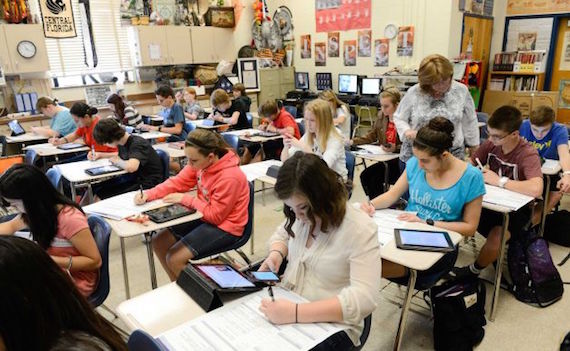
History class – online research
My gut has always told me that student-centered classrooms are important, but my outlook on how MUCH control to give students has shifted for me over time. I still plan many of my lessons with the anticipatory set / instruction, practice, review/assessment model in mind, but also incorporate open-ended student driven assignments and projects at other junctures.
While many teachers continue to teach “from the front of the room,” it appears that an unprecedented number have decided to rely on student-led inquiry and PBL with very limited direct instruction. But while I fall more on the student-driven end of the spectrum, I cannot believe that the “best” way of teaching history is at either extreme of these two poles.
Let’s consider some pros and cons for both styles of teaching in the history classroom, using the terms student-directed and teacher-directed fairly broadly.
Pros of student-directed history classes
► To me, the biggest incentive to teach history through student inquiry is that when students have autonomy in any part of the process – choosing content, research methods, mode of sharing, mode of presenting – they are so, so much more invested. If one were to arrange an entire history curriculum around a guiding question that students could research collaboratively, contextualize vertically or horizontally (content wise), and demonstrate understanding in whatever way speaks to them…well, there would probably be some really engaged students.
► Collaboration is obviously a strong part of student-directed curricula/pedagogy; in collaboration, students can learn in conversation, and use iterative and other problem-solving processes together, to better prepare them for what we think *might* be the workplace of the future.
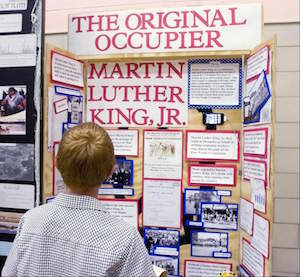
It is so much better for the history classroom if the issues they ponder, and what they discover in their journey through history, feels meaningful and applicable in the current moment, for them or for their world. We’ve written here before about how hard it is sometimes to connect the abstract and remote past to the realness of “now.”
Cons of student-directed history classes
I’ve done PBL units and assessments, but still haven’t quite been able to fully integrate PBL into the classroom for a whole year’s worth of curriculum. Why? Because I struggle with a persistent feeling that my students need more teacher direction. And I don’t think I am the only inquiry-oriented teacher with this spectrum issue.

► Maturity is an issue as well; developmentally, some students don’t have the ability to contextualize or put content into perspective yet. Those students may need some direction from the teacher–not just as a guide who is helping to monitor a small group’s work, but who is shaping a learning experience for the class.
► Then there’s the question of what’s interesting at the moment versus what’s really valuable (and even available) to know. Because they are young, adolescents do not always know what is best or what is out there. If someone had asked my thirteen-year-old self what I wanted to learn about all year, I would have picked only things I was interested in (the Salem Witchcraft Trials, probably) and would never have learned about anything else. This is a con of self-directed learning. That, and not everyone will be motivated and hungry for more! Most students can respond positively to autonomy, but not everyone is self-directed.
Pros of teacher directed history classes
► This will be a controversial thing to say, because I so rarely lecture, and I make my students work in groups all the time, but I personally LOVE lectures. I just want to sit and hear an interesting story about history — I don’t want to have to DO anything. Some of my favorite classes that I’ve taken throughout my life have been teacher driven/lecture driven. So while this kind of format has fallen somewhat out of favor, it does speak to some students (no pun intended).
► Not all teacher driven classes are lectures. As I said above, many of my classes follow the anticipatory set/instruction/practice/review format, and this is a very neat package-y way to present material. Students get a bit of everything: the anticipatory set connects to them personally (I hope), the introduction contextualizes the topic in the unit and in the larger historical context, and then students work to discover and practice on their own. It’s a strong model, with a fair portion of direct teacher instruction, and the organization really helps both teachers and students to set objectives and students to meet those objectives.
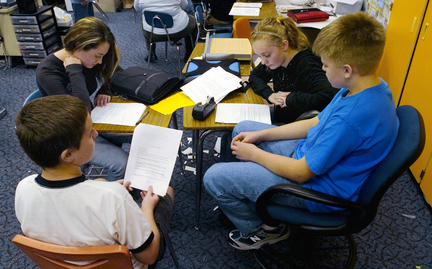
7th grade history small group
Cons of teacher directed history classes
► I said above, I really love lecture. Does this mean it’s how I learn best though? That I can’t tell you. Dewey and constructivist learning theory and proponents of PBL would say that students learn much better by doing, and my own experience may bear this out. I remember so much more when I’ve taught a concept, than when I only heard about it in lecture in graduate school.
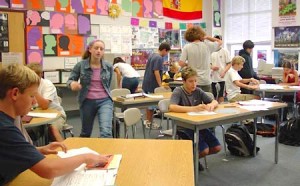
► While teacher-directed isn’t synonymous with lecture, too much can place the teacher solidly in the center of the learning experience. The students begin to revolve around the teacher, the teacher’s needs, and the teacher’s ideas about what is important. With the teacher in the “Sun” role, the students have less autonomy and then less motivation; they feel things are being done to them and can feel like they don’t have ownership over their own learning and their own work.
► Additionally, and this is especially true for history classes: now that there is SO much information available on the Internet– so much students can research about any given topic – we can’t expect them to sit still and listen to a rehash of information readily available to them. We have to involve them in some way, and we have to help them discover why the information is relevant to them.
 So What Now?
So What Now?
When I was going to school, history was all about memorization. Dates. Events. Maps and cause/effect charts. It can’t be like that anymore, but we haven’t quite figured out what it should be like. Some have moved the focus of teaching to the other side of the spectrum completely, but I wonder if that misses the point. How do we address the continuing need for teachers to guide and contextualize?
I am not advocating for the middle; I am not advocating for either of the extreme versions of teacher- or student-directed learning. But I am conflicted personally about my own practice: how do I craft an approach to history instruction that results in the right mix of interest, motivation, engagement, guidance, breadth and depth, contextualization, and relevance?
Maybe the answer is always: it depends.


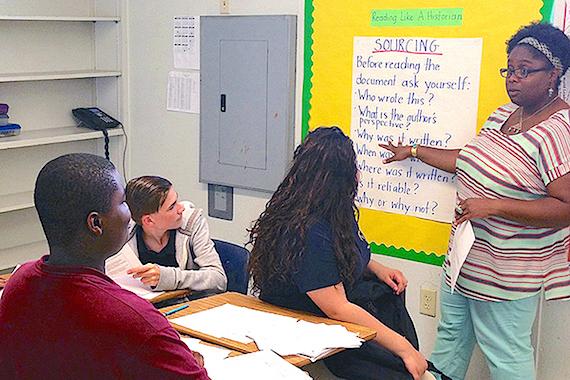
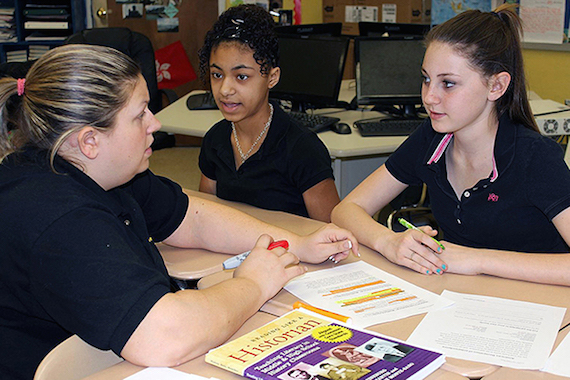


































Having a student driven class provides more scope for higher interaction between the students and the teachers and also will increase the participation of the kids and increase in a subject generally termed as boring. The students will or can when encouraged by the teacher come up with creative ways to take the lesson on their day.
I sometimes, do not have time to cover everything I want, for a particular subject. For instance, Ancient Egypt, my students seem to enjoy choosing from a list of topics and the format to present or teach the class. I have them present on the smart board. It seems they are always engaged and it seems to coincide with their different abilities, for the most part.
Many of us are restricted by state standards and a division wide pacing schedule that does not allow for the time consuming PBLs that we want to do. I agree that maturity plays a deciding factor in what you want the outcome to be versus what actually happens. I struggle everyday with how to let them engage with the learning based on their inquiring minds while knowing I am being held accountable to a test with “facts.” It is during this dilemma when we as educators know our students and adjust to their learning needs and capabilities. Sometimes I just wish administrators knew that too. PS: I LOVE a good history story and like to tell them too! :)
I think it depends on your students. I work at a high poverty school. I have tried the student centered approach. Unfortunately, most of my students are so far below grade level in reading and have so little background knowledge of anything, that they simply cannot access the content on their own. I try to provide them with pertinent information that I can help them access, and then let them work with that information in various creative ways.
I agree that is absolutely depends on your students. In comparison, I teach at a school in a district that is comparatively affluent. I have tried and done the student-centered approach. Just because these students might embrace it somewhat does not prove that the strategy will work equally everywhere.
I agree that it absolutely depends on your students. In comparison, I teach at a school in a district that is comparatively affluent. I have tried and done the student-centered approach. Just because these students might embrace it somewhat does not prove that the strategy will work equally everywhere.